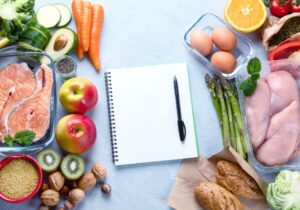A diet that meets all of your body’s dietary needs includes foods from each of the five food groups. Fill half of your plate with vegetables and fruit, particularly nonstarchy options such as broccoli, leafy greens, and squash. Incorporate some whole grains for additional fiber and B vitamins.
Fruits & Vegetables
Fruits and vegetables form the cornerstone of a balanced diet. They provide essential vitamins, minerals, and phytochemicals while being low in saturated fat, salt, and sugar—helping protect against heart disease, high blood pressure, stroke, cancer, and obesity. Fruits and vegetables provide low-calorie meals that can replace foods higher in fat, sugar, and sodium content. Their slow-digesting carbohydrates provide essential energy sources.
Be mindful when choosing fruit- and veggie-rich diets; avoid juices that contain added sugars, like fruit juice. Aim to consume fruits and veggies of different colors whenever possible and select seasonal varieties when possible. Frozen, fresh, canned, and dried produce all count—rinse your canned vegetables first to reduce sodium. Use vegetables in stews, soups, salads, and sandwiches & wraps while including beans (which count as vegetables!) in meals for a protein and fiber boost.
Grains
Grains are essential components of a balanced diet and offer essential nutrients such as complex carbohydrates, fiber, B vitamins, iron, and protein. Grains can be found in bread, cereal, pasta, rice, muffins, popcorn, bagels, and tortillas—foods that form part of their consumption.
Opt for whole grains over refined ones. Whole grains still contain their bran and germ layers for maximum nutrition benefits; refined ones have had these vital components removed. When selecting grains that provide 10% or more of an essential nutrient’s recommended daily value in one standard-size serving, then they are considered good sources.
Add barley, bulgur, quinoa, millet or spelt to soups and stews as an ingredient or base for salads; enjoy chewy textures by including rye toast; Start your day right by including oatmeal for breakfast—eating whole grains can help lower cholesterol, lower blood pressure, and aid digestion while providing a complete source of protein that’s essential in building cells, tissue muscles, and more.
Dairy
Dairy products are an integral component of a balanced diet, providing key vitamins and nutrients such as calcium, vitamin D, potassium, and protein, as well as dietary fiber. Most people would benefit from increasing their dairy consumption through lower-fat milk varieties, low-fat yogurt products, or lactose-free options.
Milk and other dairy foods such as cheese, yogurt, and butter are rich sources of protein and calcium, with many additional vitamins and minerals provided by fortifying them with vitamins or mineral supplements. While many individuals choose not to eat dairy due to lactose intolerance, veganism, or other health reasons, eating three servings a day will meet your nutrient requirements and increase health benefits—please refer to the Dairy Gallery for more details and recipes that use milk and dairy foods!
Meat & Poultry
Meat, poultry, and fish provide our bodies with essential protein as well as other important nutrients like iodine, iron, and zinc—as well as the B vitamins thiamin, niacin, and B12. However, they may contain high levels of saturated fats and sodium content. Chicken and turkey tend to contain less fat than red meats, though their fat content can still vary widely. Removing skin and avoiding deep-frying are two effective strategies for decreasing poultry’s overall fat content.
Always choose lean cuts of meat, and consume at the recommended serving size. Avoid processed meats and reduce salt and saturated fat consumption as much as possible. People who choose not to consume any red meat but only poultry or fish (flexitarians) or both (pollotarians or semi-vegetarians). When purchasing meat for consumption, ensure it is cooked thoroughly before storage to prevent food poisoning.
Fats & Oils
Fatty acids provide energy to the body while aiding absorption of fat-soluble vitamins (A, D, E, and K). Choose foods low in saturated fats, such as nuts and seeds, vegetables, olives, and fish, for best results. Oils are liquid fats used in cooking or packaged foods like mayonnaise and salad dressings that typically consist of monounsaturated and polyunsaturated “good” fats such as monounsaturates.
Carbs and fats often receive negative press due to fad diets. But if eaten in moderation, these nutrients should be a key part of a balanced diet. Be mindful about choosing appropriate food items when selecting your menu plan.
Fill half your plate with nonstarchy vegetables and fruits, adding one quarter plate of grains (ideally whole-grain sources with higher fiber levels) for balance. Aim to consume three servings of lean meat/poultry per week as well as at least two or more omega-3-rich fish each week.
Snacks
Many people view snacks as treats or something they consume between meals, but selecting smart and healthy snack options can actually improve mental focus and prevent energy slumps. Opt for low-sugar alternatives with carbohydrates, proteins, and healthy fats as sources of nourishment.
Foods that feature both crunchy and soft textures make excellent snacks. Snacks combining carbohydrates and proteins, like yogurt with granola or hard-boiled eggs with avocado slices, are also good options. Aim for snacks under 200 calories that include at least 3 grams of fiber or protein for optimal snacking!
As part of your efforts to stay healthy, be sure to inspect the serving sizes of packaged snacks and look for those that contain less added sugar and salt. Keep unhealthy options out of the house by placing them higher up on the shelves or at the back of the refrigerator where they will be harder to reach.




